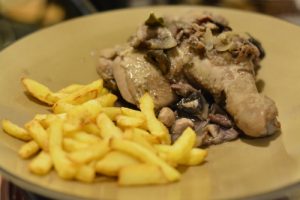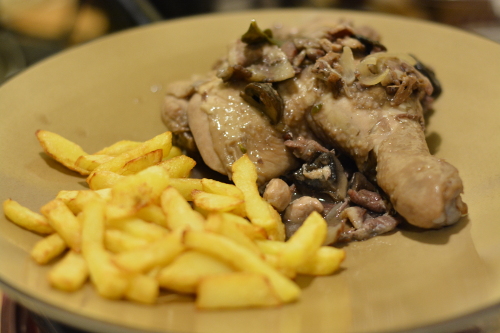
This recipe, from “Ons Kookboek” (Dutch for Our Cook Book), requires flambeing with cognac. Because it was his birthday, The Husband got the honors.
(To read the older posts in this blog, click here.)
So far our Omnivore’s Delight hasn’t made much of a difference in the pocket book. The veggies from the garden are practically free, those from our Siena Farms year-round CSA are prepaid, and I find that the extra veggies I buy at the farmers market are the same price as their organic counterparts at Whole Foods. Often they are cheaper, as when I get tomato seconds for sauce and soup. Even Day 1’s stew beef from Codman Farm in Lincoln (7 miles) wasn’t an ordeal ($9.49 for a little over a pound): it was superb, very lean and tasty, and the goulash made for dinner for three and lunch for two.
Today is my husband’s birthday party, and I cooked one of his favorites, coq-au-vin (chicken in red wine), for seven. So back to Codman Farm it was to peruse the freezers there (they carry chicken, beef, porch, and chicken eggs). It was a bit of a shock: $14.99/lb for boneless breast (Whole Foods: $4.99/lb), $7.69/lb. for bone-in leg and thigh. I got about 1 lb of the first, 5 lbs of the second and the bill came to $56.30. As I was driving home you know what I was thinking. This had better be some mighty good chicken!
I understand why it is so expensive, I do. They’re tiny operation. Economics of scale? Not by a long shot! And you just have to stroll around the farm and see how good these chickens have it: pasture-raised, organic-fed (the supplemental feed is from Green Mountain Feed in Vermont). And this does translate into their flavor. Everyone commented on how tender and tasty the chicken was. Yes, yes.
But one thing is certain: if local chicken still costs (the equivalent of) $14.99/lb. in 2060, the food system will be as, if not more, broken and inequitable than it is today. When we talked about piloting the Omnivore’s Delight in the NERT Food group, we agreed that cost should figure in our considerations. Cost is after all directly related to the social justice aspect of the Food Vision. Food Solutions New England states:
Through the strength of our connections and collaborative efforts, we believe we can produce much more of our food while developing new locally owned food businesses in our communities – from rural to urban – all with healthy working conditions and livable wages. We believe that our food system can build greater economic equity and security through flourishing farming, fishing, and food-related enterprises. We believe in the power of vision, aspiration, and collaboration that builds the sense of trust and community that feeds a truly equitable sustainable food system; one that ensures sustainable farming and fishing, access to healthy and abundant food by and for all people and thriving communities.

With “Belgian fries” (local potatoes), deep fried twice in non-local canola oil. The sauce is non-local red wine, mushrooms, bacon (Codman Farm had run out), and papper and salt.
Of course, it’s not 2060 yet. There is time to work on this. The first step has been taken by passionate, incredibly hard-working people whose love of good food, happy animals and the land overrides the need for a job security and a stable income. Now it’s up to the customers to grow the demand for the food they grow, so these small businesses can become more stable and so that other farmers can get started as well. These first customers pay a premium, just as the early adopters of solar paid much higher prices. They got that market going, then prices went down and others with less disposable income could get in.
This is an over-simplification, of course, but without those first customers the process will never get going. The question is: can our household be that customer? If we eat less of it, we could. We already do this for other meat: we eat much less of it, and when we do we buy the better quality (and as of now, also the local) meat. It makes for more appreciative eating as well, not just because it tastes better, but because we cook it with so much care and it becomes a rarer feast (no pun intended). As for chicken, we could go exclusively dark meat.
Adaptation will be required of all of us in the future as our food systems undergo economic and climate shocks and as we work toward sustainable, healthy and equitable food for all.
{UPDATE}
I am copying a comment here that was emailed to me and that I agree with. It about true cost and fair pricing – a dimension I failed to address. I agree with what the commenter writes. I only want to add that these concerns are valid for chickens as well as soy-beans.
But one thing is certain: if local chicken still costs (the equivalent of) $14.99/lb. in 2060, the food system will be as, if not more, broken and inequitable than it is today.

